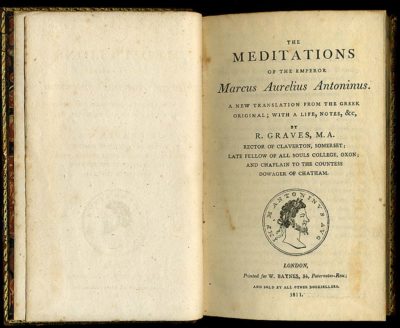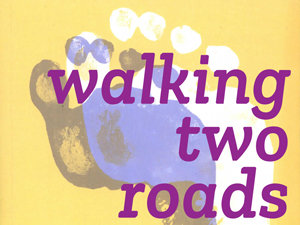Hans van Rappard
13 ― From: Rappard, H. van (2009). Walking Two Roads ― Accord and Separation In Chinese and Western Thought. Amsterdam: VU University Press. Chapter 5, pp. 144-148.
part 1 – part 2 – part 3 – part 4 – part 5 – part 6 – part 7 – part 8 – part 9 – part 10 – part 11 – part 12 – part 13 – part 14 – part 15 – part 16 – part 17

Well known Greek Stoics are Zeno (334-262 BCE), the founder of the school, and Chrysippus (ca. 280-ca. 206 BCE) but not much of their work survives.
Later, when Stoicism was introduced to the Roman world by Cicero (106-43 BCE), it became the virtually unrivalled philosophy of the higher classes and, as mentioned, even attracted the adherence of emperor Marcus Aurelius. Hence, our knowledge of the school largely stems from Roman Stoicism.
Passions as source of human suffering
To the Stoics and other Hellenistic schools ― and at first sight not entirely unlike the Chinese philosophers ― the main cause of human suffering is rooted in the passions. As the Hellenists saw them, passions are the unregulated desires and overblown fears which prevented humans from living to the full. This may have a somewhat psychotherapeutic ring about it and as said before, Martha Nussbaum has argued that Hellenistic philosophy did come down to a therapy of desire.
Analogous to medicine it was understood as a ‘toning up’ of the soul. But this does not tell the whole story because the Stoics, quite unlike most other schools, did not turn away from politics. They did not just pursue personal change but also wanted to build a just society, arguing that this task too needs philosophical therapy. Their diagnosis of the ills of passion provided the basis for their diagnosis of the ills of the political order, while the extirpation of passion was thought capable of providing the basis for political virtue.
The Roman Stoics in particular developed astoundingly radical political views, of which some still have currency today. Nussbaum has observed that the
“idea of universal respect for the dignity of humanity in each and every person, regardless of class, gender, race, and nation … is, in origin, a Stoic idea”.[2]
Although each school designed therapies of its own, all were aimed at a profound transformation of one’s way of being. For the Stoics the suffering of human beings can be traced to their deeply ingrained inclinations to acquire or to keep possessions that may either be lost or are impossible to obtain, as well as to the fact that they try to avoid misfortunes that are just in the nature of things. Hence, the task of the philosopher is, briefly put, to educate people to only seek goods that may indeed be obtained and to try to avoid only those evils that may indeed be avoided. But how is one to know this? This is where human freedom comes in.

Free and moral acts
For something good to be always within reach, or for an evil to be always avoidable it must wholly depend on one’s freedom and the only things that meet this condition are moral good and evil. It is only moral goods’ that truly depend on us; everything else does not because it is governed by the chain of cause and effect which eludes our freedom. The latter category constitutes the domain of nature and one is counselled to accept everything that pertains to it as an act of fate. Here, human action is to no avail.
This view entails an incisive reversal of our way of looking at things. It requires a shift from the ‘human’ common sense vision of reality in which actions are thought to be dependent on the passions, to a ‘natural’ vision in which each event is placed within the incomparably wider perspective of the cosmos.
Later we will have more to say about this shift of perspective but at this point it can surely be appreciated that it will not be an easy thing to accomplish ― not a bit easier in any case than it was for Plato or Augustine.
The transformation of one’s all too human way of looking at world and life was impossible to achieve without exercising, and quite relentlessly at that. Things were not seen differently in China and elsewhere and this is why in various corners of the globe systematic spiritual exercises have been developed, which little by little make possible a metamorphosis of the self.
Although no systematic treatises on the Stoic exercises survive ― provided that they were ever committed to writing in the first place ― much information has come to us by way of allusions in other writings. But there are two lists of spiritual exercises, which give a fairly complete panorama of Stoic philosophical therapeutics. One list mentions research, thorough investigation, reading, listening, attention, self-mastery, and indifference to things that are ‘indifferent’ because they do not depend on us. On the other list are found reading, meditations, therapies of the passions, remembrance of good things, self-mastery, and the accomplishment of duties.[4]
It is to be noted that even if it does not seem to have a high priority on these lists, attention is the fundamental attitude. Attention assumes a continuous vigilance and presence of mind, and a constant tension of the spirit. As long as these attitudes prevail, the Stoic is at every moment aware of what he does and ‘wills his actions fully’. Uninterrupted spiritual vigilance enables him to always have near at hand the fundamental rule of life: the distinction between what depends on us, and what does not.
Concentration on the present moment
In Stoicism but no less in Epicureanism it is of paramount importance that the philosophers always have at their elbow a brief, clear, and simple principle or rule (kanon), which is easily accessible to the mind and may be applied with the quickness and reliability of a reflex. Such a rule has to be applied to all situations in which the philosopher happens to find himself. ‘You must not separate yourself from these general principles; don’t sleep, eat, drink, or converse with other men without them’, the Stoics were admonished.
This attitude, Hadot points out, may be defined as concentration on the present moment and is the key to spiritual exercises at large. Thus, attention to the present moment is a crucial element of the training of philosophers, not only for the Stoics and the Epicureans but actually for all those to whom spiritual exercises mattered. Indeed, the full awareness of the ‘now’ was so important in Hellenism ― and also in China, as we know ― that it warrants fuller treatment later this chapter. At this point we will continue our review of some of the other exercises mentioned on the lists.
Spiritual training
Since spiritual training does not just deal with intellectual knowledge but with the transformation of our entire personality, imagination and affectivity must also be brought to bear on the training. This may be done by formulating the principle in the most striking and concrete way possible; life’s events must continuously be seen in its light. This is known as the exercise of memorisation and meditation on the rule (kanon).
The aim of meditation is to control the inner dialogue, the endless inner chatter that we have had an opportunity to observe while seated in our easy chairs and which again proves to be not just a modern phenomenon. The Stoics tried to guard themselves against this unstoppable inner noise by having it revolve around the simple, universal principle that we are now familiar with: the distinction between what does and does not depend on us, that is, the distinction between freedom and nature.
Stoic meditation

The Stoic meditator tried to keep himself prepared for the occurrence of the problems of life, especially death, by continuously keeping in mind that since they do not depend on us they are not to be thought of as evils. This helped the Stoic to accept the vicissitudes of life because ultimately they are simply part of life and nature. Hence, when faced with difficult circumstances persuasive formulas or brief sentences are to be repeated to oneself in order to check fear or anger or other movements of the heart.
First thing in the morning, the duties of the day ahead must be reviewed and the rules to guide one’s actions selected, while in the evening the day should be reviewed again with a view to faults and progress that have been made. Dreams are scrutinised as well. Various ways are open to the meditator; he may carry out his reflections by means of a dialogue with himself or others, while writing also constitutes a way towards the transformation of his views, his inner climate, and his outer behaviour.
Stoic meditation is supported by a number of exercises mentioned in the lists: reading, listening, research, and investigation, which are geared to providing food for the meditator’s thought.
Stoic exercises
For instance, one may read the sayings of the philosophers of one’s school, or the explanations of their more philosophical texts. Such texts could also be read or listened to during philosophical instruction by a professor. Educated thus, the disciple would be in the position to study the philosophy which sustained the kanon, and the physical and logical research that it comprised and summarised. And finally, the investigation resulted from putting the intellectual instructions into practice. Thus, the students are told to ‘impersonalise’ objects and events by defining them from a physical point of view, that is, they must be pictured as they appear when seen from the all-embracing cosmic perspective.
Last but not exactly least, there are practical exercises. Designed to create habits, they entailed practical behaviours such as self-mastery and fulfilling the duties of social and political life, which were in any case much emphasised by the Stoics. Treatises on such exercises bore titles as On restraining anger, On the love of wealth, On envy and hatred, and the like. With regard to the exercises in general, one simple principle is invariably recommended: begin practising on easier things, so as to gradually acquire a stable, solid habit.
For the Stoic, then, doing philosophy meant practising how to ‘live’: that is, how to live freely and consciously. Consciously, in that we pass beyond the limits of individuality, to recognize ourselves as a part of the reason-animated cosmos. Freely, in that we give up desiring that which does not depend on us and is beyond our control, so as to attach ourselves only to what depends on us: actions which are just and in conformity with reason”.[6]
- Bett, R. (2006). Stoic ethics. In M.L. Gill & P. Pellegrin (Eds.). A companion to ancient philosophy (pp. 530-548). Oxford: Blackwell.
- Green, C.D. & Groff, P.R. (2003). Early psychological thought: Ancient accounts of mind and soul. Westport (CT): Praeger.
- Hadot, P. (1995). Philosophy as a way of life ― Spiritual exercises from Socrates to Foucault. (A.I. Davidson, ed.; Chase, Transl). Oxford: Blackwell.
- Hadot, P. (2002). What is ancient philosophy? (M. Chase, Transl). Cambridge (MA): Harvard U.P.
- James, W. (1890/1950). The principles of psychology, Vol. I. New York. Dover Publ.
- Long, A.A & Sedley, D.N. (1987). The Hellenistic philosophers, Vol. I. Cambridge: Cambridge U.P.
- Nussbaum, M.C. (1994). The therapy of desire: Theory and practice in Hellenistic ethics. Princeton: Princeton U.P.
- Staniforth, M. (Transl). (2004). Marcus Aurelius: Meditations. London: Penguin Books.
Notes
[1] Source: The young Cicero reading – Vincenzo Foppa (fresco, 1464)
[2] Nussbaum, 1994, p. 12
[3] Source: Stoics
[4] Hadot, 1995, pp. 84-86
[5] Source: Titlepage of an 1811 edition of Meditations by Marcus Aurelius Antoninus, translated by R. Graves
[6] Hadot, 1995, p. 86



